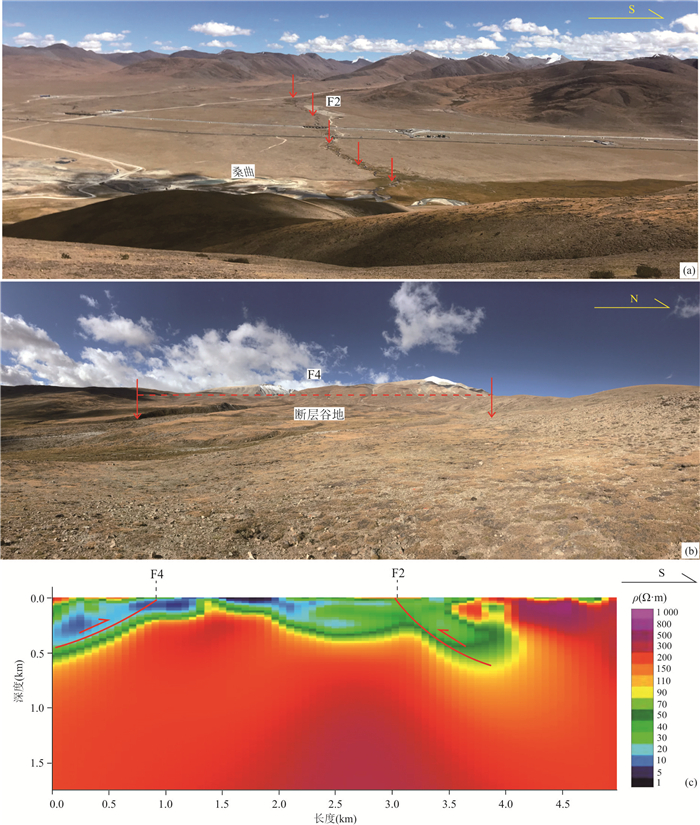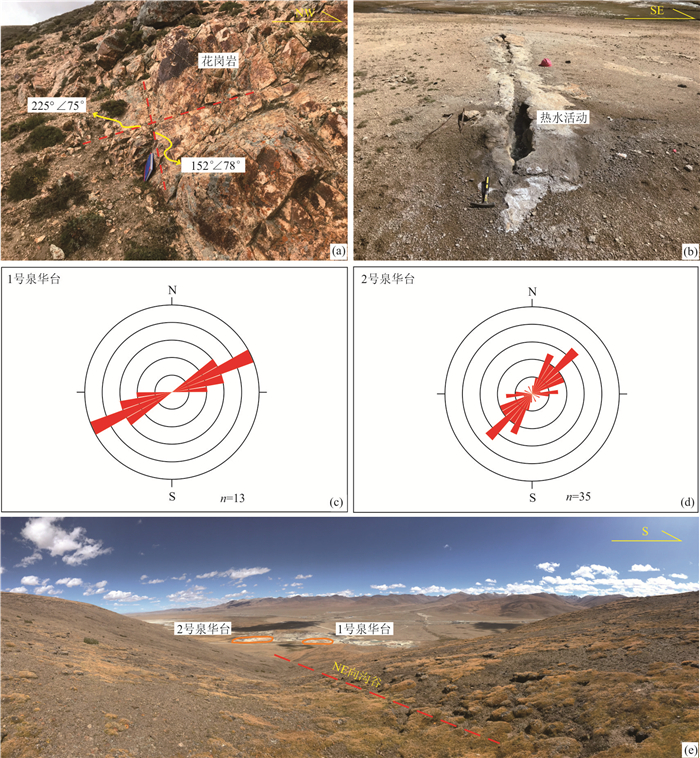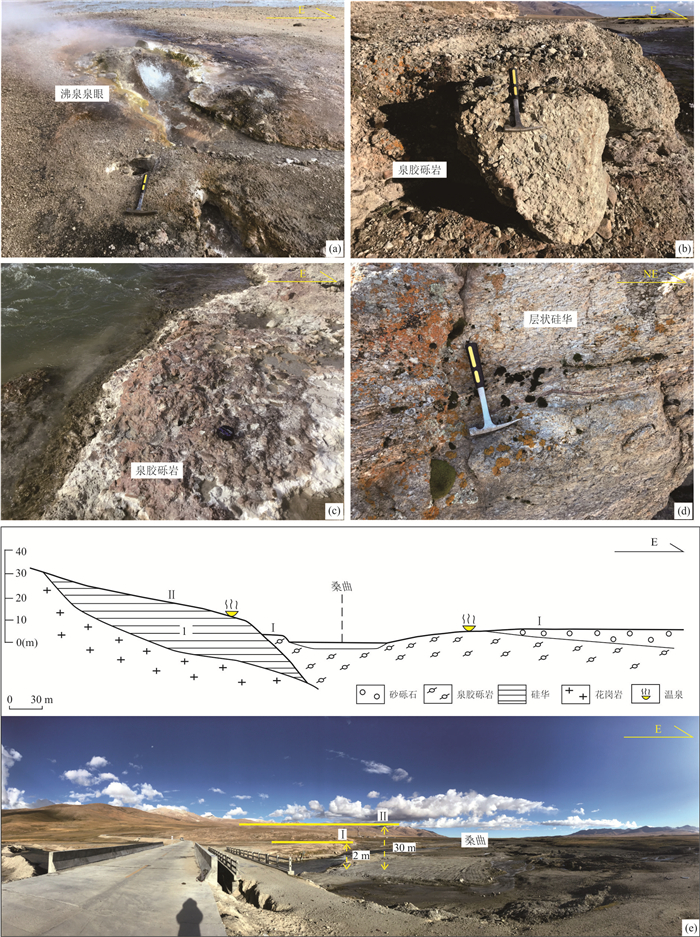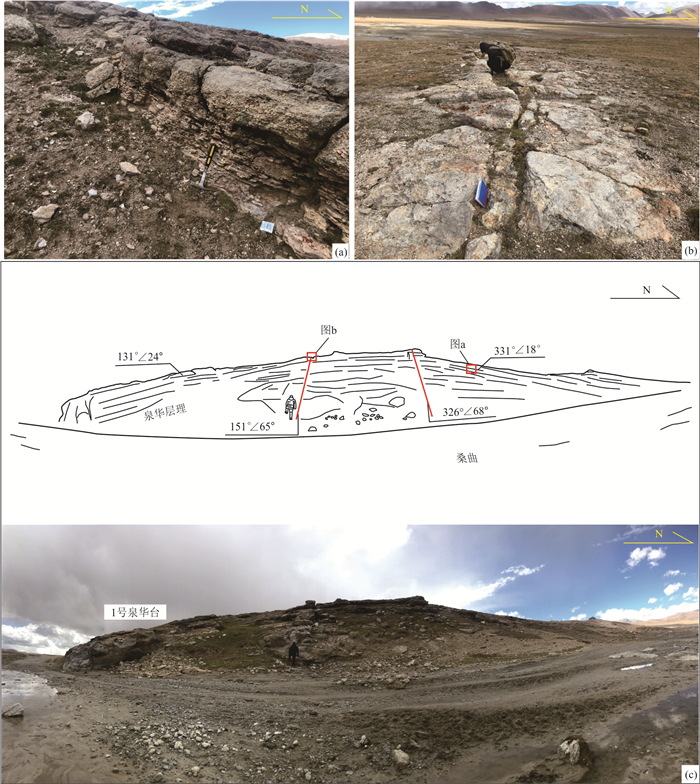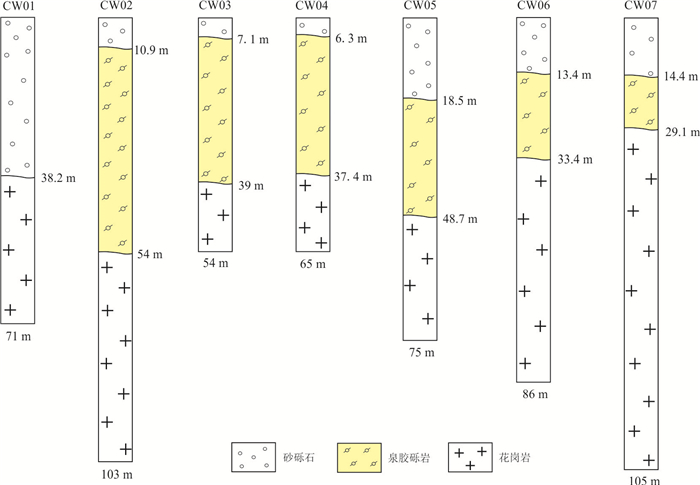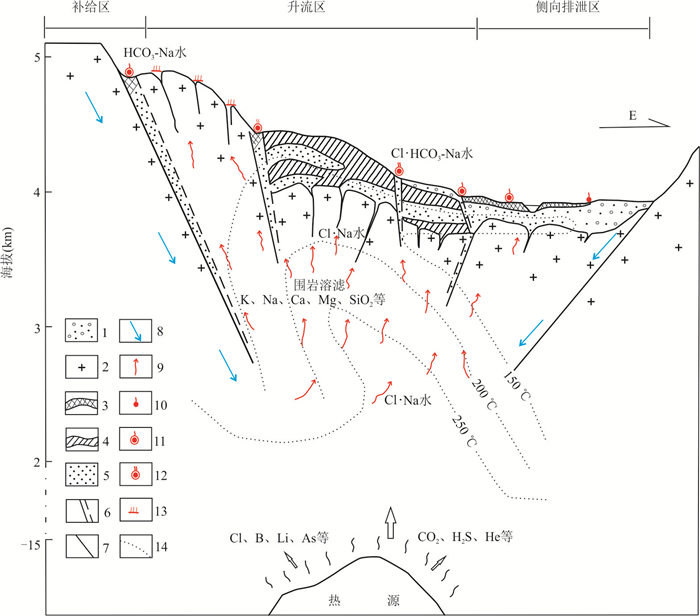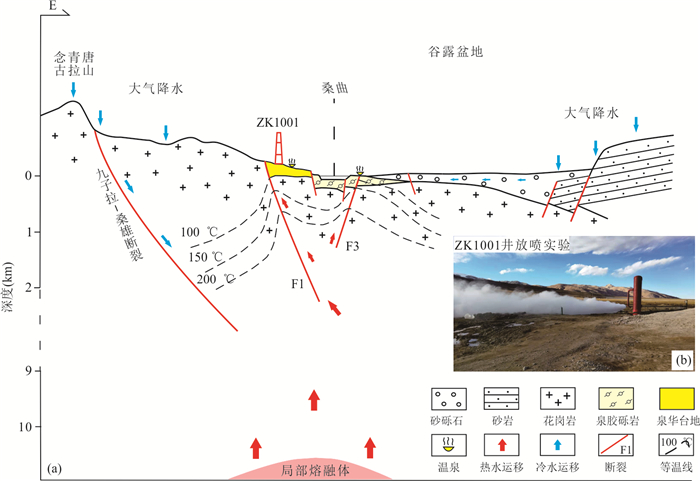Characteristics of Geothermal Geology of the Gulu Geothermal Field in Tibet
-
摘要: 西藏谷露地热田于2020年成功揭露到189.2 ℃的高温地热资源,研究谷露地热田地热地质特征,对西藏地热资源勘查开发和揭示高温地热系统成因机理都具有重要的科学与指导意义.本文以构造地质调查为基础,结合最新物探、钻探、水文资料,通过解析构造‒水‒热循环系统内在联系,总结构造控热规律,并建立了谷露地热田地热系统概念模型.谷露地热田内主要发育N-S向(F1、F3)、E-W向(F2、F4)和NE向3组断裂.大气降水与冰山融水沿盆地西侧九子拉‒桑雄断裂下渗,经深循环加热以盆地西缘F1断裂为导热通道向上运移,由于受到南北两侧F2、F4断裂的阻隔作用,热水在F1和F3断裂组成的“Y”字型断裂系统内汇聚集中,形成热储,并在地表沿NE向和N-S向断裂构成的通道系统中运移排泄;盆地基底花岗岩之上覆盖的泉胶砾岩层对热储起到了良好的隔水保温作用;热田内第四系沉积很薄,热储主要赋存于基岩裂隙中,为基岩裂隙型热储.F1与F3构成的“Y”字型断裂系统是热储赋存的主要场所,谷露地热田地热资源勘查开发要以这两条断裂为重点勘查目标.Abstract: The Gulu geothermal field successfully revealed high temperature thermal reservoir of 189.2 ℃ in 2020, therefore, studying geothermal geological characteristics of the Gulu geothermal field can be significant for guiding geothermal development and helpful for revealing the high temperature geothermal system mechanism. Based on the structural geological survey, combined with the latest geophysical, drilling, and hydrological data, this paper summarizes the structural thermal control laws of the Gulu geothermal field by analyzing the internal connection of the structure-water-thermal cycle system, and establishes a conceptual model of the geothermal system. The faults of the Gulu geothermal field can be divided into 3 groups: N-S trending (F1, F3), E-W trending (F2, F4) and NE trending. Atmospheric precipitation and iceberg meltwater migrated deep along the Jiuzila-Sangxiong fault, and were heated by deep heat sources to form high-temperature geothermal fluids, and rose along the F1 fault at the edge of the basin. The hot water was blocked by the F2 and F4 faults near surface, converging into thermal reservoir, migrating and draining along the channel system which formed by the N-S and NE faults; The conglomerate cemented by sinter overlying the basement granite played a role in ensuring water and thermal insulation for thermal reservoir. The Quaternary sediments were very thin in geothermal field, and the thermal reservoir was mainly stored in the bedrock fissures. According to the results, the "Y"-shaped fault system formed by F1 and F3 faults is the main storage place for thermal reservoir, and these two faults can be regarded as the main target for deep geothermal exploration.
-
图 3 谷露地热田E-W向断裂特征
a. F2断裂地貌特征;b. F4断裂地貌特征;c. AMT剖面L1;位置见图 2a
Fig. 3. Characteristics of E-W trending faults in Gulu geothermal field
图 4 谷露地热田N-S向断裂特征
a. F1断裂错断中更新统冰水堆积层;b. F1断裂错断马里组砂岩;c. 断层面上斜向擦痕;d. 断层滑动矢量应力反演图;e. F3断裂地貌特征;f. 热水泉眼沿F3断裂线状出露;位置见图 2a
Fig. 4. Characteristics of N-S trending faults in Gulu geothermal field
图 5 谷露地热田NE向断裂特征
a. 肉红色花岗岩中共轭节理;b. 2号泉华台表面NE向裂隙,热水通道;c. 1号泉华台表面裂隙统计玫瑰花图;d. 2号泉华台表面裂隙统计玫瑰花图;e. 泉华台西侧NE向沟谷延伸通过泉华台地,位置见图 2a
Fig. 5. Characteristics of NE trending faults in Gulu geothermal field
图 6 谷露地热田热水活动与泉华分布
a.泉华台表面沸泉;b.桑曲西岸泉胶砾岩;c.桑曲河床底部红褐色泉胶砾岩;d.层状硅华;e.两级泉华台地地貌特征与地质剖面,位置见图 2a
Fig. 6. The distribution of hot water activity and sinter in Gulu geothermal field
图 8 谷露地热田测温井钻孔柱状图
位置见图 2b
Fig. 8. Histogram of boreholes of temperature measurement wells in Gulu geothermal field
-
Armijo, R., Tapponnier, P., Mercier, J. L., et al., 1986. Quaternary Extension in Southern Tibet: Field Observations and Tectonic Implications. Journal of Geophysical Research Atmospheres, 91(B14): 13803-13872. https://doi.org/10.1029/jb091ib14p13803 Bian, S., Yu, Z. Q., Gong, J. F., et al., 2021. Spatiotemporal Distribution and Geodynamic Mechanism of the nearly NS⁃Trending Rifts in the Tibetan Plateau. Journal of Geomechanics, 27(2): 178-194 (in Chinese with English abstract). Brown, L. D., Zhao, W. J., Nelson, K. D., et al., 1996. Bright Spots, Structure, and Magmatism in Southern Tibet from INDEPTH Seismic Reflection Profiling. Science, 274(5293): 1688-1690. https://doi.org/10.1126/science.274.5293.1688 Chen, Y. J., Gao, J. C., Feng, J. J., et al., 1992. A Preliminary Study on the History of Hydrothermal Activities Occurred in Southern Tibetan. Hydrogeology and Engineering Geology, 19(5): 18-21, 24 (in Chinese with English abstract). Duo, J., 2003. The Basic Characteristics of the Yangbajing Geothermal Field-A Typical High Temperature Geothermal System. Engineering Science, 5(1): 42-47 (in Chinese with English abstract). Feng, Z. J., Zhao, Y. S., Zhou, A. C., et al., 2012. Development Program of Hot Dry Rock Geothermal Resource in the Yangbajing Basin of China. Renewable Energy, 39(1): 490-495. https://doi.org/10.1016/j.renene.2011.09.005 Guo, Q. H., Wang, Y. X., Liu, W., 2007. Major Hydrogeochemical Processes in the Two Reservoirs of the Yangbajing Geothermal Field, Tibet, China. Journal of Volcanology and Geothermal Research, 166(3-4): 255-268. https://doi.org/10.1016/j.jvolgeores.2007.08.004 Guo, Q. H., Yang, C., 2021. Tungsten Anomaly of the High⁃Temperature Hot Springs in the Daggyai Hydrothermal Area, Tibet, China. Earth Science, 46(7): 2544-2554 (in Chinese with English abstract). Ha, G. H., Wu, Z. H., Liu, F., 2019. Late Quaternary Vertical Slip Rates along the Southern Yadong⁃Gulu Rift, Southern Tibetan Plateau. Tectonophysics, 755: 75-90. https://doi.org/10.1016/j.tecto.2019.02.014 He, Z. H., Yang, D. M., Wang, T. W., 2007. Geochemistry and Tectonic Setting of Miocene Granitoids near Gulou Area, Gangdise Belt. Journal of Jilin University (Earth Science Edition), 37(1): 31-37 (in Chinese with English abstract). Hu, Z. H., Gao, H. L., Wan, H. P., et al., 2022. Temporal and Spatial Evolution of Hydrothermal Alteration in the Yangbajing Geothermal Field, Xizang(Tibet). Geological Review, 68(1): 359-374 (in Chinese with English abstract). Huang, J. C., Liang, H. J., Gu, X. X., 2021. Development Situation of Geothermal Energy in China and Development Proposals in the 14th Five⁃Year Plan Period. World Petroleum Industry, 28(2): 41-46 (in Chinese with English abstract). Li, Z. Q., 2002. Present Hydrothermal Activities during Collisional Orogenics of the Tibetan Plateau (Dissertation). Chinese Academy of Geological Sciences, Beijing, (in Chinese with English abstract). Liu, J., Shen, X. H., Meng, K., et al., 2009. Preliminery Studies on the Late Quaternary Activity of the Western Margin Fault of Gulu Basin, Tibet. Earthquake, 29(3): 45-53 (in Chinese with English abstract). Liu, M. L., He, T., Wu, Q. F., et al., 2020. Hydrogeochemistry of Geothermal Waters from Xiongan New Area and Its. Earth Science, 45(6): 2221-2231 (in Chinese with English abstract). Liu, Q. S., Wu, Z. H., Ye, P. S., et al., 2005. Isotopic Dating of the Nyainqentanglha Granite and Its Significance. Acta Geologica Sinica, 79(3): 331-337 (in Chinese with English abstract). Liu, Z., 2014. The Forming Mechanism of Typical High⁃Temperature Geothermal Systems in Nimu⁃Naqu Geothermal Belt, Tibet (Dissertation). Chinese Academy of Geological Sciences, Beijing (in Chinese with English abstract). Liu, Z., Lin, W. J., Zhang, M., et al., 2014. Geothermal Fluid Genesis and Mantle Fluids Contributions in Nimu⁃Naqu, Tibet. Earth Science Frontiers, 21(6): 356-371 (in Chinese with English abstract). http://www.researchgate.net/publication/286308204_Geothermal_fluid_genesis_and_mantle_fluids_contributions_in_Nimu-Naqu_Tibet Nelson, K. D., Zhao, W. J., Brown, L. D., et al., 1996. Partially Molten Middle Crust beneath Southern Tibet: Synthesis of Project INDEPTH Results. Science, 274(5293): 1684-1688. https://doi.org/10.1126/science.274.5293.1684 Pang, Z. H., Hu, S. B., Wang, J. Y., 2012. A Roadmap to Geothermal Energy Development in China. Science & Technology Review, 30(32): 18-24 (in Chinese with English abstract). Qin, J. S., 2003. Hydrothermal Alteration and Evalution in Yangyi Geothermal Field. Journal of Taiyuan University of Technology, 34(2): 161-165 (in Chinese with English abstract). Tong, W., Zhang, M. T., Zhang, Z. F., et al., 1981. Geothermals Beneath Xizang(Tibetan) Plateau. Science Press, Beijing, 18-19 (in Chinese). Wang, J. Y., Pang, Z. H., Kong, Y. L., et al., 2020. Status and Prospects of Geothermal Clean Heating Industry in China. Science & Technology for Development, 16(S1): 294-298 (in Chinese with English abstract). Wang, S. G., Chevalier, M. L., Pan, J. W., et al., 2020. Quantification of the Late Quaternary Throw Rates along the Yadong Rift, Southern Tibet. Tectonophysics, 790: 228545. https://doi.org/10.1016/j.tecto.2020.228545 Wu, Z. H., Hu, D. G., Liu, Q. S., et al., 2005. Chronological Analyses of the Thermal Evolution of Granite and the Uplift Process of the Nyainqentanglha Range in Central Tibet. Acta Geosicientia Sinica, 26(6): 505-512 (in Chinese with English abstract). Wu, Z. H., Zhao, X. T., Wu, Z. H., et al., 2006a. Quaternary Geology and Faulting in the Damxung⁃Yangbajain Basin, Southern Tibet. Journal of Geomechanics, 12(3): 305-316 (in Chinese with English abstract). Wu, Z. H., Wu, Z. H., Hu, D. G., et al., 2006b. Holocene Seismogenic Faults along the Tanggula⁃Lhasa Section of the Qinghai⁃Tibet Railway, China. Geological Bulletin of China, 25(12): 1387-1401 (in Chinese with English abstract). Xu, S. G., Guo, Y. S., 2009. Geothermal Fundamentals. Science Press, Beijing, 19-21 (in Chinese). Xu, Z. K., Xu, S. G., Zhang, S. T., 2021. Hydro⁃Geochemistry of Anning Geothermal Field and Flow Channels Inferring of Upper Geothermal Reservoir. Earth Science, 46(11): 4175-4187 (in Chinese with English abstract). Zhang, M., Lin, W. J., Liu, Z., et al., 2014. Hydrogeochemical Characteristics and Genetic Model of Gulu High⁃Temperature Geothermal System in Tibet, China. Journal of Chengdu University of Technology (Science & Technology Edition), 41(3): 382-392 (in Chinese with English abstract). doi: 10.3969/j.issn.1671-9727.2014.03.15 Zhao, W. J., Jiang, W., Wu, Z. H., et al., 2003. Study on Deep Structure⁃Seismic⁃Geothermal Relationship and Mechanism of Yangbajing in Tibet. Chinese Academy of Geological Sciences, Beijing, 95-97 (in Chinese). Zhao, W. J., Zhao, X., Shi, D. N., et al., 2002. Progress in the Study of Deep (INDEPTH) Profiles in the Himalayas and Qinghai⁃Tibet Plateau. Regional Geology of China, 21(11): 691-700 (in Chinese with English abstract). Zhao, Y. Y., Fan, X. T., Han, J. Y., et al., 2009. Geologic and Geochemical Features and Ore Forming Process for Hot Spring Cesium Deposit of Gulu Area, Nagqu Region, Tibet, China. Geological Bulletin of China, 28(7): 933-954 (in Chinese with English abstract). doi: 10.3969/j.issn.1671-2552.2009.07.014 Zhao, Y. Y., Zhao, X. T., Ma, Z. B., et al., 2010. Chronology of the Gulu Hot Spring Cesium Deposit in Nagqu, Tibet and It Geological Significance. Acta Geologica Sinica, 84(2): 211-220 (in Chinese with English abstract). Zheng, K. Y., Zheng, F., 2020. Discussion on Prospects of Geothermal Power Generation Industry in China. Sino⁃Global Energy, 25(11): 17-23 (in Chinese with English abstract). Zheng, M. P., Wang, Q. X., Duo, J., et al., 1995. A New Type of Hydrothermal Deposit⁃Cesium⁃Bearing Geyserite in Tibet. Geological Publishing House, Beijing, 27-32 (in Chinese with English abstract). 卞爽, 于志泉, 龚俊峰, 等, 2021. 青藏高原近南北向裂谷的时空分布特征及动力学机制. 地质力学学报, 27(2): 178-194. https://www.cnki.com.cn/Article/CJFDTOTAL-DZLX202102004.htm 陈以健, 高钧成, 冯锦江, 等, 1992. 藏南的水热活动历史初探. 水文地质工程地质, 19(5): 18-21, 24. https://www.cnki.com.cn/Article/CJFDTOTAL-SWDG199205008.htm 多吉, 2003. 典型高温地热系统: 羊八井热田基本特征. 中国工程科学, 5(1): 42-47. https://www.cnki.com.cn/Article/CJFDTOTAL-GCKX200301007.htm 郭清海, 杨晨, 2021. 西藏搭格架高温热泉中钨的水文地球化学异常. 地球科学, 46(7): 2544-2554. doi: 10.3799/dqkx.2020.287 和钟铧, 杨德明, 王天武, 2007. 冈底斯带谷露区中新世花岗岩地球化学特征及构造环境. 吉林大学学报(地球科学版), 37(1): 31-37. https://www.cnki.com.cn/Article/CJFDTOTAL-CCDZ200701004.htm 胡志华, 高洪雷, 万汉平, 等, 2022. 西藏羊八井地热田水热蚀变的时空演化特征. 地质论评, 68(1): 359-374. https://www.cnki.com.cn/Article/CJFDTOTAL-DZLP202201027.htm 黄嘉超, 梁海军, 谷雪曦, 2021. 中国地热能发展形势及"十四五"发展建议. 世界石油工业, 28(2): 41-46. https://www.cnki.com.cn/Article/CJFDTOTAL-SSYY202102009.htm 李振清, 2002. 青藏高原碰撞造山过程中的现代热水活动(博士学位论文). 北京: 中国地质科学院. 刘静, 申旭辉, 孟恺, 等, 2009. 谷露盆地西缘断裂晚第四纪活动初步研究. 地震, 29(3): 45-53. https://www.cnki.com.cn/Article/CJFDTOTAL-DIZN200903006.htm 刘明亮, 何曈, 吴启帆, 等, 2020. 雄安新区地热水化学特征及其指示意义. 地球科学, 45(6): 2221-2231. doi: 10.3799/dqkx.2019.270 刘琦胜, 吴珍汉, 叶培盛, 等, 2005. 念青唐古拉花岗岩的同位素年龄测定及其地质意义. 地质学报, 79(3): 331-337. https://www.cnki.com.cn/Article/CJFDTOTAL-DZXE200503007.htm 刘昭, 2014. 西藏尼木‒那曲地热带典型高温地热系统形成机理研究(博士学位论文). 北京: 中国地质科学院. 刘昭, 蔺文静, 张萌, 等, 2014. 西藏尼木‒那曲地热流体成因及幔源流体贡献. 地学前缘, 21(6): 356-371. https://www.cnki.com.cn/Article/CJFDTOTAL-DXQY201406040.htm 庞忠和, 胡圣标, 汪集旸, 2012. 中国地热能发展路线图. 科技导报, 30(32): 18-24. https://www.cnki.com.cn/Article/CJFDTOTAL-KJDB201232015.htm 秦进生, 2003. 西藏羊易地热田的水热蚀变及地热地质意义. 太原理工大学学报, 34(2): 161-165. https://www.cnki.com.cn/Article/CJFDTOTAL-TYGY200302016.htm 佟伟, 章铭陶, 张知非, 等, 1981. 西藏地热. 北京: 科学出版社, 18-19. 汪集旸, 庞忠和, 孔彦龙, 等, 2020. 我国地热清洁取暖产业现状与展望. 科技促进发展, 16(S1): 294-298. https://www.cnki.com.cn/Article/CJFDTOTAL-KJCJ2020Z1010.htm 吴珍汉, 胡道功, 刘琦胜, 等, 2005. 念青唐古拉花岗岩热演化历史和山脉隆升过程的热年代学分析. 地球学报, 26(6): 505-512. https://www.cnki.com.cn/Article/CJFDTOTAL-DQXB200506003.htm 吴中海, 赵希涛, 吴珍汉, 等, 2006a. 西藏当雄‒羊八井盆地的第四纪地质与断裂活动研究. 地质力学学报, 12(3): 305-316. https://www.cnki.com.cn/Article/CJFDTOTAL-DZLX200603003.htm 吴中海, 吴珍汉, 胡道功, 等, 2006b. 青藏铁路唐古拉山‒拉萨段全新世控震断裂研究. 地质通报, 25(12): 1387-1401. https://www.cnki.com.cn/Article/CJFDTOTAL-ZQYD200612005.htm 徐世光, 郭远生, 2009. 地热学基础. 北京: 科学出版社, 19-20. 徐梓矿, 徐世光, 张世涛, 2021. 安宁地热田浅部热储水化学特征及补给通道位置. 地球科学, 46(11): 4175-4187. doi: 10.3799/dqkx.2020.401 张萌, 蔺文静, 刘昭, 等, 2014. 西藏谷露高温地热系统水文地球化学特征及成因模式. 成都理工大学学报(自然科学版), 41(3): 382-392. https://www.cnki.com.cn/Article/CJFDTOTAL-CDLG201403015.htm 赵文津, 江万, 吴珍汉, 等, 2003. 西藏羊八井深部构造‒地震‒地热关系及机理调查研究. 北京: 中国地质科学院, 95-97. 赵文津, 赵逊, 史大年, 等, 2002. 喜马拉雅和青藏高原深剖面(INDEPTH)研究进展. 地质通报, 21(11): 691-700. https://www.cnki.com.cn/Article/CJFDTOTAL-ZQYD200211000.htm 赵元艺, 樊兴涛, 韩景仪, 等, 2009. 西藏谷露热泉型铯矿床地质地球化学特征与成矿作用. 地质通报, 28(7): 933-954. https://www.cnki.com.cn/Article/CJFDTOTAL-ZQYD200907016.htm 赵元艺, 赵希涛, 马志邦, 等, 2010. 西藏谷露热泉型铯矿床年代学及意义. 地质学报, 84(2): 211-220. https://www.cnki.com.cn/Article/CJFDTOTAL-DZXE201002007.htm 郑克棪, 郑帆, 2020. 中国地热发电产业前景探讨. 中外能源, 25(11): 17-23. https://www.cnki.com.cn/Article/CJFDTOTAL-SYZW202011005.htm 郑绵平, 王秋霞, 多吉, 等, 1995. 水热成矿新类型: 西藏艳硅华矿床. 北京: 地质出版社, 27-32. -










 下载:
下载:

